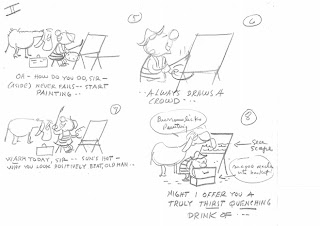In
readying the 50
th anniversary edition of the book, I did a little more research into the
facilities where
Mr. Magoo's Christmas Carol was recorded
-the dialogue, the
songs and the score.
In the first
edition, I had chased all that information down, even to looking for the vaults
where the recorded material might have been stored.
This time I was more interested in the
recording facilities themselves and briefly considered adding images of the studios to the book while providing
a little more history on the places.
Unfortunately, inserting this material proved disruptive to the narrative flow of
the book so I decided to post it on the blog.
 |
| Altec Lansing crew, ca. 1944 |
The
dialogue recording sessions were done at 1161 Vine Street in Hollywood at Ryder
Sound Services.
Prior to serving as a
recording and post-production studio for Ryder, the facility was the Hollywood headquarters
of Altec Lansing, a pioneer in the field of recorded sound with an impressive
list of accomplishments in the industry. However, they were best known for providing and servicing
sound systems for motion picture theaters.
They also helped promote professional quality sound systems for home use
or, as it was known during the 50s, hi-fi.
 |
| Photo from 2009, facade has since been covered by vegetation. |
Loren
Ryder took over the facility after leaving his job at Paramount after a 20 year
association.
Ryder, was a true engineering
pioneer in the field of motion picture sound, helping to develop and usher in the
era of magnetic tape.
Along the way, he
won 5 Academy Awards for his work in motion pictures.
He had started his own business in 1948 but
continued to work for Paramount until 1957 when he left for good.
Ryder’s reputation made the facility a highly
regarded one, and his operation was kept busy by the then burgeoning business
of TV production.
For decades, this building was
home to entertainment sound engineering history.
Although UPA had a recording studio, as
with many of the pre-production aspects of
Mr. Magoo's Christmas Carol, Orgel went for the best,
booking his dialogue sessions at Ryder Sound Services.
The late Laura Olsher recalled that between the day's sessions, the actors went
upstairs for lunch at a place called The Grapevine.
I have not been able to find corroborating
information regarding the restaurant but I have no reason to doubt her
memory.
A real estate listing from a few
years ago shows a loft, which would have been the eatery in its heyday.
At
the time of the recording sessions, the building still retained its old LA
charm. Since then, it has seen a a variety of uses, and has lost some of its original appeal, being painted a deep red with vegetation allowed to
obscure its façade. It’s currently home to
Stereo D, a provider of 3D conversion services to the motion picture industry.




































